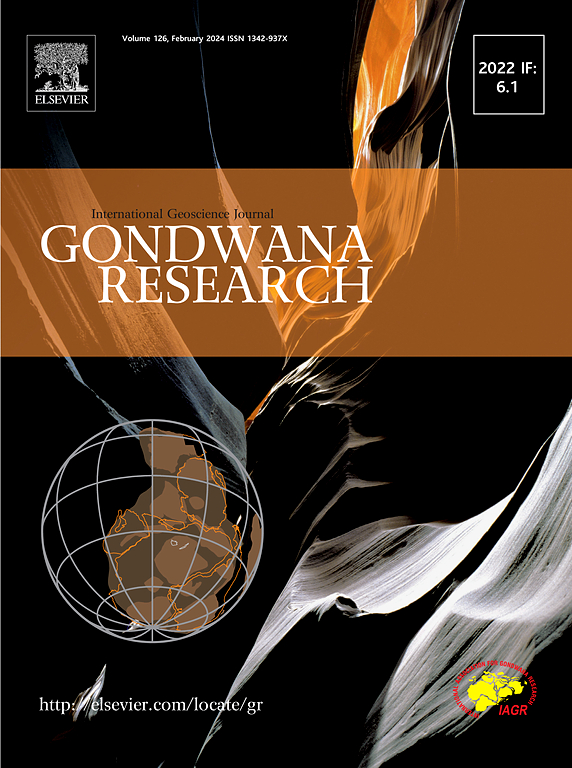Volcanism-driven synchronous terrestrial and marine anoxia during the Kungurian (early Permian)
IF 7.2
1区 地球科学
Q1 GEOSCIENCES, MULTIDISCIPLINARY
引用次数: 0
Abstract
During the Late Paleozoic Icehouse (LPI) interval from the Late Devonian to the Late Permian, Earth transitioned repeatedly between icehouse to greenhouse conditions and widespread ocean anoxic conditions prevailed in the Kungurian stage of the Permian. Previous studies of Kungurian anoxia have focused on marine strata, and the driving mechanism for these dramatic environmental and climatic changes are poorly understood. We studied Kungurian-aged deltaic deposits from the Yuzhou Coalfield in the southern North China Platform to investigate terrestrial environmental conditions contemporaneous with anoxic marine strata. A significant anoxic interval was recognized by high-resolution mineralogical and geochemical analyses that coincides with the Kungurian negative carbon isotope excursion (KCIE) and peaks in Hg/TOC ratio. Proxy evidence from the Yuzhou Coalfield shows this anoxic interval was accompanied by warmer and more humid climates, high paleo-productivity, and strong continental weathering. We attribute early Kungurian anoxia in the Yuzhou Coalfield to carbon cycle perturbation due to its synchronous occurrence with the KCIE and volcanism in the Tarim and Zaduo large igneous provinces. Based on the relationship between pCO2 concentration and carbon isotope fractionation, we suggest that volcanic eruptions, magma intrusions into organic-rich storage, and methane hydrate dissolution released large quantities of isotopically depleted carbon into the atmosphere, leading to the KCIE. Massive emissions of volcanic Hg contributed to the mercury anomaly in sedimentary strata. Global climatic warming likely enhanced oceanic evaporation and intensified the hydrological cycle, resulting in increased continental weathering, terrestrial runoff and nutrient inputs, as well as water stratification and widespread bottom water anoxia in marine and terrestrial settings. Our results show that Kungurian anoxia occurred synchronously in both marine and freshwater settings, as it did in the stratigraphically younger Toarcian (T-OAE) and Cretaceous (OAE1a and OAE1b) Ocean Anoxic Events (OAEs).

昆古里安(早二叠世)火山驱动的同步陆海缺氧
晚泥盆世-晚二叠世晚古生代冰窖(LPI)时期,地球在冰窖-温室条件之间反复过渡,二叠世昆古里安阶段普遍存在海洋缺氧条件。以往对昆固缺氧的研究主要集中在海洋地层,对这些剧烈的环境和气候变化的驱动机制知之甚少。以华北地台南部禹州煤田昆久连期三角洲沉积为研究对象,探讨与缺氧海相地层同时期的陆相环境条件。高分辨率的矿物学和地球化学分析发现了一个明显的缺氧层段,与Kungurian负碳同位素偏移(KCIE)和Hg/TOC比值峰相吻合。禹州煤田的代用证据表明,这一缺氧期段伴随着温暖湿润的气候、高古生产力和强烈的大陆风化作用。禹州煤田Kungurian早期缺氧与塔里木和扎多大火成岩省的KCIE和火山活动同步发生,导致碳循环扰动。基于pCO2浓度与碳同位素分馏的关系,我们认为火山喷发、岩浆侵入富有机质储层以及甲烷水合物溶解将大量同位素贫碳释放到大气中,导致了KCIE的形成。火山汞的大量排放导致了沉积地层中汞的异常。全球气候变暖可能加剧了海洋蒸发,加剧了水文循环,导致大陆风化、陆地径流和养分输入增加,以及海洋和陆地环境中的水分层和广泛的底水缺氧。研究结果表明,Kungurian缺氧在海洋和淡水环境中是同步发生的,就像在地层较年轻的Toarcian (T-OAE)和白垩纪(OAE1a和OAE1b)海洋缺氧事件(oae)中一样。
本文章由计算机程序翻译,如有差异,请以英文原文为准。
求助全文
约1分钟内获得全文
求助全文
来源期刊

Gondwana Research
地学-地球科学综合
CiteScore
12.90
自引率
6.60%
发文量
298
审稿时长
65 days
期刊介绍:
Gondwana Research (GR) is an International Journal aimed to promote high quality research publications on all topics related to solid Earth, particularly with reference to the origin and evolution of continents, continental assemblies and their resources. GR is an "all earth science" journal with no restrictions on geological time, terrane or theme and covers a wide spectrum of topics in geosciences such as geology, geomorphology, palaeontology, structure, petrology, geochemistry, stable isotopes, geochronology, economic geology, exploration geology, engineering geology, geophysics, and environmental geology among other themes, and provides an appropriate forum to integrate studies from different disciplines and different terrains. In addition to regular articles and thematic issues, the journal invites high profile state-of-the-art reviews on thrust area topics for its column, ''GR FOCUS''. Focus articles include short biographies and photographs of the authors. Short articles (within ten printed pages) for rapid publication reporting important discoveries or innovative models of global interest will be considered under the category ''GR LETTERS''.
 求助内容:
求助内容: 应助结果提醒方式:
应助结果提醒方式:


